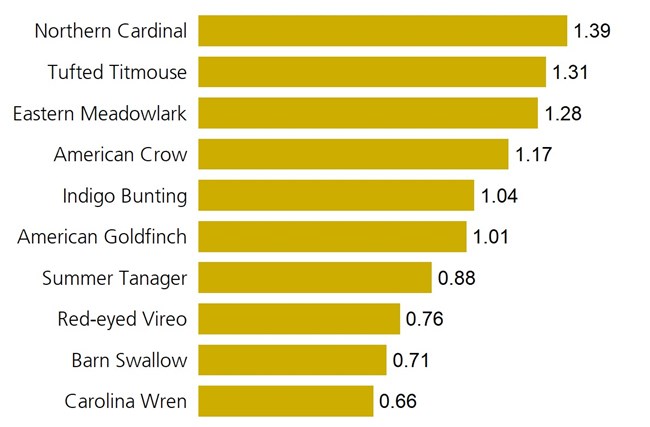Last updated: April 6, 2021
Article
Breeding Bird Populations at Colonial National Historical Park (2015–2019)

Bill Thompson
Park staff and skilled local volunteers have worked together over the years to monitor bird populations at Colonial National Historical Park. The information gathered is used to improve our understanding of the relationships between breeding birds, available habitats, and park resource management. The goal of the monitoring is to develop the best available science so national parks can better understand and protect their resources. This brief provides a summary of breeding bird monitoring results for Colonial National Historical Park from 2015–2019.
During the summers of 2015–2019, volunteers conducted a total of 196 surveys at 50 monitoring sites. During a survey, the volunteers documented every bird heard or seen over a 10 minute period. Sites in both forest and grassland habitat were visited multiple times during the breeding season.
Warm-season grass meadows can serve the dual benefit of supporting birds and preserving open space at national parks. Results from 2015–2019 show that some grassland associated birds, like bobwhite quail — a regional species of conservation concern — are present but remain very rare.

Bill Thompson
Highlights
- During summers from 2015–2019, volunteers conducted a total of 196 surveys at 50 monitoring sites.
- Several species of regional conservation concern were documented in relatively high numbers, including wood thrushes, ovenbirds, and yellow-billed cuckoos.
- Forest bird community index scores suggest moderate to high ecological health of the park’s forest bird communities.
Species of Regional Concern
The Partners in Flight Program is a network of organizations involved in bird conservation in the Western Hemisphere. This program has identified a number of bird species that are declining and facing increasing threats across the mid-Atlantic region. These birds are of particular interest to park managers, and 18 “species of regional concern” were observed during 2015–2019 bird monitoring at the park. The top ten most abundant species of regional concern are listed below.

Bill Thompson
| Common name | Total number of observations |
|---|---|
| Wood thrush | 78 |
| Ovenbird | 67 |
| Yellow-billed cuckoo | 35 |
| Swamp sparrow | 31 |
| Eastern kingbird | 17 |
| Brown thrasher | 14 |
| Field sparrow | 10 |
| Northern bobwhite | 10 |
| Eastern towhee | 9 |
| Scarlet tanager | 9 |

Grassland Sites
Northern cardinals, tufted titmice, and eastern meadowlarks were the three most common birds observed in grasslands at the park from 2015–2019. Eastern meadowlarks are considered a “common species in steep decline” by the Partners in Flight Program. This species is dependent upon open grasslands and does particularly well in warm-season grass meadows and can be found nesting in the battlefields of Yorktown. Management to support increased acreage of warm-season grasses would be beneficial to a number regionally declining species, including eastern meadowlarks.

Bill Thompson

Forested Sites
The three most abundant birds in forested monitoring sites during 2015-2019 were the tufted titmouse, northern cardinal, and the red-eyed vireo. Acadian flycatchers were also relatively abundant. Red-eyed vireos and Acadian flycatchers depend upon large expanses of mature forest habitat. Given the increasing urbanization occurring around the park, the high abundance of these species shows the importance of maintaining healthy park forests for local bird populations.

Bill Thompson

Forest Bird Community Index Score
Scientists can study the abundance of all the bird species in an area to determine the overall health of the bird community. The forest bird community index score (O’Connell et al., 2000*) for the park shows that the forest bird community has moderate to high ecological health. Continued management for mature forest habitat should help maintain or increase this score. That said, given increased urbanization around the park, the conservation of mature forests on surrounding public and private lands may also be important for the long-term persistence of park forest bird communities.
*T.J. O’Connell, L.E. Jackson, and R.P Brooks. 2000. Bird guilds as indicators of ecological condition in the central Appalachians. Ecological Applications, 10(6).
